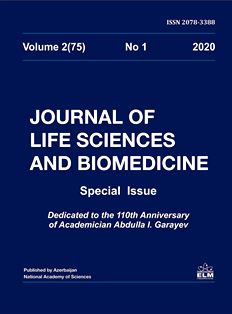
Neurodegeneration as mitochondrial pathology: Signaling mechanisms and new routes for life-time diagnostics and targeted therapy (review)
Research article: Neurodegeneration as mitochondrial pathology: Signaling mechanisms and new routes for life-time diagnostics and targeted therapy (review)
Authors: I. Kvetnoy1,2,3, N. Linkova2,4, Y. Krylova1,5, T. Kvetnaia2, U. Hashimova6*, A. Gadzhiev6*, V. Polyakova7
1Saint Petersburg Research Institute of Phthysiopulmonology, 2-4 Ligovsky Ave., Saint Petersburg 191036, Russian Federation
2Saint Petersburg Institute of Bioregulation and Gerontology, 3 Dinamo Ave, Saint Petersburg 197110, Russian Federation
3Saint Petersburg State University, 79 University Str., Saint Petersburg 199034, Russian Federation
4 Academy of Postgraduate Education under FSBU FSCC of FMBA of Russia, 91 Volokolamsk Ave., Moscow125371, Russian Federation
5 Pavlov First Saint Petersburg State Medical University, 6-8 Lev Tolstoy Str., Saint Petersburg 197022, Russian Federation
6Academician Abdulla Garayev Institute of Physiology, Azerbaijan National Academy of Sciences, 78 Sharifzadeh Str., Baku AZ1100, Azerbaijan
7Saint Petersburg State Pediatric Medical University, 2 Litovskaya Str., Saint Petersburg194100, Russian Federation
* For correspondence: ulduz.hashimova@science.az; ahmed.hajiyev@yandex.ru
Accepted for publication: 24 April 2020
Abstract:
Structural and functional alterations of mitochondria have been shown to be responsible for a wide variety of clinical disorders that are referred to as “mitochondrial diseases”. It is now obvious that many factors are involved in transport of mitochondrial proteins including cytokines, chaperones, chemokines, neurosteroids, ubiquitin and many others. At the same time, the participation and the role of biogenic amines and peptide hormones (which are produced by the diffuse neuroendocrine system cells located in different organs) in endogenous mechanisms of mitochondrial diseases are still unknown. Taking into account the wide spectrum of biological effects of biogenic amines and peptide hormones, and especially their regulatory role for intracellular communication, it seems important to analyze the possible participation of these molecules in the pathogenesis of mitochond- rial disorders as well as to draw up a new way for elaboration of a new markers for lifetime diagno- sis, definition of prognosis and efficiency of specific therapy in neurodegenerative diseases.
Keywords: Mitochondrial diseases, biogenic amines, peptide hormones, diffuse neuroimmunoendocrine system, lifetime diagnostics, neurodegeneration
References
Acuna-Castroviejo D., Coto-Montes A., Monti M.G. et al. (1997) Melatonin is protective aga-inst MPTP-induced striatal and hippocampal le-sions. Life Sci., 60: 23-29.
Alves-Rodrigues A., Gregori L., Figueiredo-Pe-reira M.E. (1998) Ubiquitin, cellular inclusions and their role in neurodegeneration. Trends Neu-rosci., 21: 516-520.
Ames B.N., Shigenaga M.K., Hagen T.M. (1993) Oxidants, antioxidants, and the degenera-tive diseases of aging. Proc. Natl. Acad. Sci. USA, 90: 7915-7922.
Aronin N., Coslovsky R., Leeman S.E. (1986) Substance P and neurotensin: their role in the re-gulation of anterior pituitary function. Annu. Rev. Physio.l, 48: 537-549.
Asensio V.C., Campbell I.L. (1999) Chemokines in the CNS: plurifunctional mediators in diverse states. Trends Neurosc.i, 22: 504-512.
Auld D.S., Kar S., Quirion R. (1998) -Amyloid peptides as direct cholinergic neuromodulators: a missing link? Trends Neurosci., 21: 43-49.
Barlow-Walden L.R., Reiter R.J., Abe M. et al. (1995) Melatonin stimulates brain glutathione peroxidase activity. Neurochem. Int., 26: 497-502.
Baskin D.G., Figlewicz D.P., Woods S.C. et al. (1987) Insulin in the brain. Annu. Rev. Physiol., 49: 335-347.
Beal M.F., Benoit R., Mazurek M.F. et al. (1986) Somatostatin-28 (1-12)-like immunoreactivity is reduced in Alzheimer’s disease cerebral cortex. Brain Res, 368: 380-383.
Beal M.F. (1990) Somatostatin in neurodegenera-tive illnesses. Metabolism, 39 (9, Suppl 2): 116-119.
Blass J.P., Baker A.C., Ko L. et al. (1991) Exp-ression of “Alzheimer antigens” in cultured skin fibroblasts. Arch. Neurol., 48: 709-717.
Bolanos J.P., Almeida A., Stewart V. et al. (1997) Nitric oxide-mediated mitochondrial da-mage in the brain: mechanisms and implications for neurodegenerative diseases. J. Neurochem., 68: 2227-2240.
Borjigin J., Li X., Snyder S.H. (1999) The pineal gland and melatonin: molecular and phar-maco-logic regulation. Annu. Rev. Pharmacol. Toxicol., 39: 53-65.
Boyd F.T., Clarke D.W., Muther T.F., Raizada M.K. (1985) Insulin receptors and insulin mo-dulation of norepinephrine uptake in neuronal cultures from rat brain. J. Biol. Chem., 260: 15880-15884.
Brazeau P., Vale W., Burgus R. et al. (1973) Hypothalamic polypeptide that inhibits the sec-retion of immunoreactive pituitary growth hor-mone. Science, 179: 77-79.
Brown M., Rivier J., Vale W. (1979) Somatosta-tin: central nervous system actions on glucore-gulation. Endocrinology, 104: 1709-1715.
Brown M.R. (1983) Central nervous system sites of action of bombesis and somatostatin to influ-ence plasma epinephrine levels. Brain Res., 276: 253-257.
Calhoun M.E., Wiederhold K-H., Abramowski D. et al. (1998) Neuron loss in APP transgenic mice. Nature, 395: 755-756.
Chiso E., Nicolosi M., Arvat E. et al. (1993) Growth hormone secretion in Alzheimer’s disea-se: studies with growth hormone releasing hor-mone alone and combined with pyridostigmine or arginine. Dementia, 4: 315-320.
Choi D.W. (1995) Calcium: still center-stage in hypoxic-ishemic neuronal death. Trends Neuros-ci., 18: 58-60.
Ciesielski-Treska J., Ulrich G., Taupenot L. et al. (1998) Chromogranin A induces a neurotoxic phenotype in brain microglial cells. J. Biol. Chem., 273: 14339-14346. Kvetnoy et al.
Clark E.A., Brugge J.S. (1995) Integrins and sig-nal transduction pathways: the road taken. Sci-ence, 268: 233-238.
Clayton D.F., George J.M. (1998) The synucle-ins: a family of proteins involved in synaptic function, plasticity, neurodegeneration and di-sease. Trends Neurosci., 21: 249-254.
Congdon E.E., Sigurdsson E.M. (2018) Tau-tar-geting therapies for Alzheimer disease. Nat Rev Neurol., 14(7): 399-415.
Coyle J.T., Puttfarcken P. (1993) Oxidative stress, glutamate, and neurodegenerative disor-ders. Science, 262: 689-695.
Cuzzocrea S., Tan D-X., Costantino G. et al. (1999) The protective role of endogenous mela-tonin in carrageenan-induced pleurisy in the rat. FASEB J., 13: 1930-1938.
Davies A.M. (1995) The bcl-2 family of proteins, and the regulation of neuronal survival. Trends Neurosci., 18: 355-358.
Davis R.E., Miller S., Herrnstadt C. et al. (1997) Mutations in mitochondrial cytochrome c oxidase genes segregate with late-onset Alzhei-mer disease. Proc. Natl. Acad. Sci. USA, 94: 4526-4531.
De Souza E.B., Whitehouse P.J., Kuhar M.J. et al. (1986) Reciprocal changes in corticotropin-releasing factor (CRF)-like immunoreactivity and CRF receptors in cerebral cortex of Alzhei-mer’s disease. Nature, 319: 593-595.
Dehghani Z., Meratan A.A., Saboury A.A., Ne-mat-Gorgani M. (2020) α-Synuclein fibrillation products trigger the release of hexokinase I from mitochondria: Protection by curcumin, and pos-sible role in pathogenesis of Parkinson's disease. Biochim. Biophys. Acta Biomembr., 1862(6): 183251.
Devine M.J., Kittler J.T. (2018) Mitochondria at the neuronal presynapse in health and disease. Nat. Rev. Neurosci., 19(2): 63-80.
Dickson D.W. (1997) The pathogenesis of senile plaques. J. Neuropathol. Exp. Neurol., 56: 321-339.
Dines K.C., Powell H.C. (1997) Mast cell inte-ractions with the nervous system: relationship to mechanisms of disease. J. Neuropathol. Exper. Neurol., 56: 627-640.
Dumbrille-Ross A., Seeman P. (1984) Dopamine receptor elevation by cholecystokinin. Peptides, 5: 1207-1212.
Dysken M.W., Falk A., Pew B. et al. (1990) Gender differences in TRH-stimulated TSH and prolactin in primary degenerative dementia and elderly controls. Biol. Psychiatry, 28: 144-150.
Efthimiopoulos S., Vassilacopoulou D., Ripelli-no J.A. et al. (1996) Cholinergic agonists stimu-late secretion of soluble full-length amyloid pre-cursor protein in neuroendocrine cells. Proc. Natl. Acad. Sci. USA, 93: 8046-8050.
Everitt B.J., Hokfelt T., Terenius L. et al. (1984) Differential co-existence of neuropeptide Y (NPY)-like immunoreactivity with catechola-mines in the central nervous system of the rat. Neuroscience, 11: 443-462.
Fadeel B., Zhivotovsky B., Orrenius S. (1999) All along the watchtower: on the regulation of apoptosis regulators. FASEB J., 13: 1647-1657.
Fahn S., Cohen G. (1992) The oxidant stress hypothesis in Parkinson’s disease: evidence sup-porting it. Ann. Neurol., 32: 804-812.
Figlewicz D.P., Lacour F., Sipols A. (1987) Gastroenteropancreatic peptides and the central nervous system. Annu. Rev. Physiol., 49: 383-395.
Fine J.M., Forsberg A.C., Stroebel B.M. et al. (2017) Intranasal deferoxamine affects memory loss, oxidation, and the insulin pathway in the streptozotocin rat model of Alzheimer's disease. J. Neurol. Sci., 380: 164-171.
Gale L.M., McColl S.R. (1999) Chemokines: extracellular messengers for all occasions. Bio-Essaya, 21: 17-28.
Gao Y., Tan L., Yu J.T., Tan L. (2018) Tau in Alzheimer's Disease: Mechanisms and Thera-peutic Strategies. Curr. Alzheimer Res., 15(3): 283-300.
Gasparini L., Racchi M., Binetti G. et al. (1998) Peripheral markers in testing pathophysiological hypotheses and diagnosing Alzheimer’s disease. FASEB J., 12: 17-34.
Goedert M., Lightman S.L., Nagy J.I. et al. (1982) Neurotensin in the rat anterior pituitary gland. Nature, 298: 163-165.
Goltermann N.R. (1982) In vivo biosynthesis of cholecystokinin in hog cerebral cortex. Peptides, 3: 101-104.
Green D.R. (1998) Apoptotic pathways: the roads to ruin. Cell, 94: 695-698. Neurodegeneration as mitochondrial pathology: Signaling mechanisms and
Griffin S.W.T, Sheng J.G., Roberts G.W., Mrak R.E. (1995) Interleukin-1 expression in different plaque types in Alzheimer’s disease: significance in plaque evolution. J. Neuropathol. Exp. Neurol., 54: 276-281.
Grota L.J., Brown G.M. (1974) Antibodies to indolealkylamines: serotonin and melatonin. Can. J. Biochem., 52: 196-203.
Hachiya N., Alam R., Sakasegawa N. et al. (1993) A mitochondrial import factor purified from rat liver cytosol is an ATP-dependent com-formational modulator for precursor proteins. EMBO J., 12: 1579-1586.
Hernandez J.M., Giner P., Hernandez-Yago J. (1999b) Gene structure of the human mitoc-hondrial outer membrane receptor Tom20 and evolutionary study of its family of processed pseudogenes. Gene, 239: 283-291.
Hernandez J.M., Hernandez C.S., Giner C.P. et al. (1999a) Identification of 3Tom20, a no-vel processed pseudogene of the human Tom20 gene, and complete characterization of 1Tom20 and 2Tom20. Mol. Gen. Genet., 262: 207-211.
Hockenbery D, Nunez G, Milliman C et al. (1990) Bcl-2 is an inner mitochondrial membra-ne protein that blocks programmed cell death. Nature, 348: 334-336.
Hockenbery D.M., Oltvai Z.N., Yin X-M. et al. (1993) Bcl-2 functions in an antioxidant path-way to prevent apoptosis. Cell, 75: 241-251.
Iadanza M.G., Jackson M.P., Hewitt E.W. et al. (2018) A new era for understanding amyloid structures and disease. Nat. Rev. Mol. Cell. Bi-ol., 19(12):755-773.
Irwin M., Brown M., Patterson T. et al. (1991) Neuropeptide Y and natural killer cell activity: findings in depression and Alzheimer caregiver stress. FASEB J., 5: 3100-3107.
Ishii M., Hiller A.J., Pham L. et al. (2019) -amyloid-beta modulates low-threshold activated voltage-gated L-type calcium channels of arcua-te neuropeptide y neurons leading to calcium dysregulation and hypothalamic dysfunction. J. Neurosci., 39(44): 8816-8825.
Iwai A., Masliah E., Yoshimoto M. et al. (1995) The precursor protein of non-A component of Alzheimer’s disease amyloid is a presynaptic protein of the central nervous system. Neuron, 14: 467-475.
Jacobson M.D., Burne J.F., King M.P. et al. (1993) Bcl-2 blocks apoptosis in cells lacking mitochondrial DNA. Nature, 361: 365-369.
Jennes L., Stumpf W.E., Kalivas P.W. (1982) Neurotensis: topographical distribution in rat brain by immunohistochemistry. J. Comp. Neu-rol., 210: 211-224.
Kahn D., Abrams G.M., Zimmerman E.A. et al. (1980) Neurotensin neurons in the rat hypot-halamus: an immunocytochemical study. Endoc-rinology, 107: 47-54.
Kahn D., Hou-You A., Zimmerman E.A. (1982) Localization of neurotensin in the hypothalamus. Ann. NY Acad. Sci., 400: 117-131.
Kang P.J., Ostermann J., Shilling J. et al. (1990) Hsp70 in the mitochondrial matrix is re-quired for translocation and folding of precursor proteins. Nature, 348: 137-143.
Koenig H.L., Schumacher M., Ferzaz B. et al. (1995) Progesterone synthesis and myelin for-mation by Schwann Cells. Science, 268: 1500-1503.
Kraskovskaya NA, Kukanova EO, Linkova NS et al. (2017) Tripeptides Restore the Number of Neuronal Spines Under Conditions of In Vitro Modeled Alzheimer’s Disease. Bulletin of Expe-rimental Biology and Medicine, 163(4): 550-553.
Kreutzberg G.W. (1996) Microglia: a sensor for pathological events in CNS. Thends Neurosci., 19: 312-318.
Kroemer G., Dallaporta B., Resche-Rigon M. (1998) The mitochondrial death/life regulator in apoptosis and necrosis. Annu. Rev. Physiol., 60: 619-642.
Kunkl M., Frascolla S., Amormino C. et al. (2020) T Helper Cells: The Modulators of Inf-lammation in Multiple Sclerosis. Cells, 9(2): pii: E482.
Kvetnoy I.M., Sandvik A.K., Waldum H.L. (1997) The diffuse neuroendocrine system and extrapineal melatonin. J. Mol. Endocrinol., 18: 1-3.
Kvetnoy I.M., Yuzhakov V.V., Raikhlin N.T. (1997) APUD cells: modern strategy of morpho-functional analysis. Microsc. Anal., 48: 25-27. Kvetnoy et al.
Kvetnoy I.M. (1999) Extrapineal melatonin: lo-cation and role within diffuse neuroendocrine system. Histoch. J., 31: 1-12.
Larrson L-I. (1980) On the possible existence of multiple endocrine, paracrine and neurocrine messengers in secretory system. Invest Cell Pat-hol., 3: 73-85.
Lee K., Zawadzka A., Czarnocki Z. et al. (2016) Molecular cloning of melatonin 3-hydroxylase and its production of cyclic 3-hydroxymelatonin in rice (Oryza sativa). J. Pi-neal. Res., 61(4): 470-478.
Lee VM-Y., Trojanowski Q. (1999) Neurodege-nerative tauopathies: human disease and transge-nic mouse models. Neuron, 24: 507-510.
Li P., Song C. (2020) Potential treatment of Par-kinson's disease with omega-3 polyunsatu-rated fatty acids. Nutr. Neurosci., 1-12. doi: 10.1080/1028415X.2020.1735143
Li W.P., Lai H.W., Cheng S.Y., Yew D.T. (1996) Somatostatin-positive neurons in the dif-ferent parts of the brain in normal aging and Alzheimer’s disease. Biol. Signals, 5: 343-348.
Lithgow T., Ryan M., Anderson R.L. et al. (1993) A constitutive form of heat-shock protein 70 is located in the outer membranes of mitoc-hondria from rat liver. FEBS Lett., 332: 277-281.
Liu Q., Hazan A., Grinman E., Angulo J.A. (2017) Pharmacological activation of the neuro-tensin receptor 1 abrogates the methamphetami-ne-induced striatal apoptosis in the mouse brain. Brain Res., 1659: 148-155.
Ljungdahl A., Hokfelt T., Nillson G. (1978) Distribution of substance P-like immunoreacti-vity in the central nervous system of the rat. I. Cell bodies and nerve terminals. Neuroscience, 3: 861-943.
Luft R. (1994) The development of mitochondrial medicine. Proc. Natl. Acad. Sci. USA, 91: 8731-8738.
Lundberg J.M., Saria A., Franco-Cereceda A. et al. (1985) Differential effects of reserpine and 6-hydroxydopamine on neuropeptide Y (NPY) and noradrenaline in peripheral neurons. Arch. Pharmacol., 328: 331-340.
Lynn W.S., Wong P.K.Y. (1995) Neuroimmuno-degeneration: do neurons and T cells use com-mon pathways for cell death. FASEB J., 9: 1147-1156.
Martinus R.D., Ryan M.T., Naylor D.J. et al. (1995) Role of chaperones in the biogenesis and maintenance of the mitochondrion. FASEB J., 9: 371-378.
Mayo J.C., Sainz R.M., Uria H. et al. (1998) Melatonin prevents apoptosis induced by 6-hydroxydopamine in neuronal cells: implicati-ons for Parkinson’s disease. J. Pineal. Res., 24: 179-192.
Meltzer C.C., Smith G., DeKosky S.T. et al. (1998) Serotonin in aging, late-life depression, and Alzheimer’s disease: the emerging role of functional imaging. Neuropsychopharmacology, 18: 407-430.
Mennicken F., Maki R., de Souza E.B., Quirion R. (1999) Chemokines and chemokine receptors in the CNS: a possible role in neuroinflammati-on and patterning. Trends Pharmacol. Sci., 20: 73-78.
Merrill J.E., Jonakait G.M. (1995) Interactions of the nervous and immune systems in develop-ment, normal brain homeostasis, and disease. FASEB J., 9: 611-618.
Mihara K., Omura T. (1996) Cytoplasmic cha-perones in precursor targeting to mitochondria: the role of MSF and hsp70. Trends Cell Biolm., 6: 104-108.
Miklossy J., Taddei K., Martins R. et al. (1999) Alzheimer disease: curly fibers and tangles in organs other than brain. J. Neuropathol. Exp. Neurol., 58: 803-814.
Minami M., Kimura M., Iwamoto N., Arai H. (1996) Endothelin-1-like immunoreactivity in cerebral cortex of Alzheimer-type dementia. Prog. Neuropsychopharmacol. Biol. Psychiatry, 19: 509-513.
Molnar M.J., Kovacs G.G. (2017) Mitochondrial diseases. Handb. Clin. Neurol., 145: 147-155.
Monaghan P, Robertson D, Amos TAS et al. (1992) Ultrastructural localization of bcl-2 pro-tein. J. Histochem. Cytochem., 40: 1819-1825.
Morganti-Kossmann M.C., Kossmann T., Wahl S.M. (1992) Cytokines and neuropathology. Trends Pharmacol. Sci., 13: 286-291.
Mrak R.E., Griffin S.T., Graham D.I. (1997) Aging-associated changes in human brain. J. Neuropathol. Exp. Neurol., 56: 1269-1275.
Nathan C. (1992) Nitric oxide as a secretory pro-duct of mammalian cells. FASEB J., 6: 3051-3064. Neurodegeneration as mitochondrial pathology: Signaling mechanisms and
Neumann H., Wekerle H. (1998) Neuronal cont-rol of the immune response in the central nervo-us system: linking brain immunity to neurodege-neration. J. Neuropathol. Exp. Neurol., 57: 1-9.
Pallares-Trujillo J., Lopez-Soriano F.J., Argi-les J.M. (1998) The involvement of the ubiqui-tin system in Alzheimer’s disease (review). Int. J. Mol. Med., 2: 3-15.
Pang S.F. Dubocovich M.L., Brown G.M. (1993) Melatonin receptors in peripheral tissues: a new area of melatonin research. Biol. Signals, 2: 177-180.
Papadopoulos V., Guarneri P., Krueger K.E. et al. (1992) Pregnenolone biosynthesis in C6-2B glioma cell mitochondria: regulation by a mitoc-hondrial diazepam binding inhibitor receptor. Proc. Natl. Acad. Sci. USA, 89: 5113-5117.
Paul S.M., Purdy R.H. (1992) Neuroactive stero-ids. FASEB J., 6: 2311-2322.
Pearse A.G.E. (1968) Common cytochemical and ultrastructural characteristics of cells producing polypeptide hormones (the APUD series) and their relevance to thyroid and ultimobranchial C-cells and calcitonin. Proc. Roy. Soc. B., 170: 71-80.
Pearse A.G.E. (1969) The cytochemistry and ult-rastructure of polypeptide hormone-producing cells of the APUD series and the embryologic, physiologic and pathologic implications of the concept. J. Histochem. Cytochem., 17: 303-313.
Petrella C., Di Certo M.G., Barbato C. et al. (2019) Neuropeptides in Alzheimer's Disease: An Update. Curr. Alzheimer Res., 16(6): 544-558.
Phu L., Rose C.M., Tea J.S. et al. (2020) Dynamic Regulation of Mitochondrial Import by the Ubiquitin System. Mol. Cell., 77(5): 1107-1123.e10.
Plagman A, Hoscheidt S, McLimans KE et al. (2019) Cholecystokinin and Alzheimer's disea-se: a biomarker of metabolic function, neural in-tegrity, and cognitive performance. Neurobiol Aging., 76: 201-207.
Polak J.M., Bloom S.R. (1986) Immunocytoche-mistry of the diffuse neuroendocrine system. In: J.M.Polak, S.Van Noorden (eds.) Immunocytoc-hemistry: modern methods and applications. John Wright & Sons: 328-348.
Price D.L. (1999) New order from neurological disorders. Nature. 399 (Suppl): A3-A5.
Raff M.C., Barres B.A., Burne J.F. et al. (1993) Programmed cell death and the control of cell survival: lessons from the nervous system. Sci-ence, 262: 695-700.
Raikhlin N.T., Kvetnoy I.M. (1994) The APUD system (diffuse endocrine system) in normall and pathological states. Physiol. Gen. Biol. Rev., 8(4): 1-44.
Ramage L., Junne T., Hahne K. et al. (1993) Functional cooperation of mitochondrial protein import receptors in yeast. EMBO J., 12: 4115-4123.
Reinikainen K.J., Soininen H., Riekkinen P.J. (1990) Neurotransmitter changes in Alzheimer’s disease: implications to diagnostics and therapy. J. Neurosci. Res., 27: 576-586.
Reiter R.J., Guerrero J.M., Garcia J.J., Acuna-Castroviejo D. (1998) Reactive oxygen inter-mediates, molecular damage, and aging. Relati-on to melatonin. Ann. NY Acad. Sci., 854: 410-424.
Reiter R.J., Poeggeler B,. Tan D-X. et al. (1993) Antioxidant capacity of melatonin: a novel func-tion not requiring a receptor. Neuroendocr. Lett., 15: 103-116.
Reiter R.J. (1973) Comparative physiology: pi-neal gland. Annu Rev Physiol, 35: 305-328.
Reiter R.J. (1992) The ageing pineal gland and its physiological consequences. BioEssays., 14: 169-175.
Reiter R.J. (1995) Oxidative processes and antio-xidative defense mechanisms in the aging brain. FASEB J., 9: 526-533.
Reiter RJ.. (1997) Aging and oxygen toxicity: re-lation to changes in melatonin. Age, 20: 201-213.
Reiter R.J. (1998) Oxidative damage in the cent-ral nervous system: protection by melatonin. Prog. Neurobiol., 56: 359-384.
Reubi J.C., Palacios J. (1986) Somatostatin and Alzheimer’s disease: a hypothesis. J. Neurol., 233: 370-372.
Ronnekleiv O.K., Kelly M.J., Eskay R.L. (1984) Distribution of immunoreactive substan-ce P neurons in the hypothalamus and pituitary of the rhesus monkey. J. Comp. Neurol., 224: 51-59. Kvetnoy et al.
Rothwell N.J., Hopkins S.J. (1995) Cytokines and the nervous system. II. Actions and mecha-nisms of action. Trends Neurosci., 18: 130-136.
Rubanyi G.M., Botelho H.P. (1991) Endothe-lins. FASEB J., 5: 2713-2720.
Sakanaka M., Shiosaka S., Takatsuki K. et al. (1981) Experimental immunohistochemical stu-dies on the amygdalofugal peptidergic (substan-ce P and somatostatin) fibers in the stria termi-nalis of the rat. Brain Res., 221: 231-242.
Sakanaka M., Shiosaka S., Takatsuki K. et al. (1982) Origins of substance P-containing fibers in the lateral septal area of young rats: immuno-histochemical analysis of experimental manipu-lations. J. Comp. Neurol., 212: 268-277.
Sastry P.S., Rao K.S. (2000) Apoptosis and the nervous system. J. Neurochem., 74: 1-20.
Schapira A.H.V. (1993) Mitochondrial cytopat-hies. Curr. Opin. Neurobiol., 3: 760-767.
Selkoe D.J. (1998) The cell biology of -amyloid precursor protein and presenilin in Alzheimer’s disease. Trends Cell Bio.l, 8: 447-453.
Shigenaga M.K., Hagen T.M., Ames B.N. (1994) Oxidative damage and mitochondrial de-cay in aging. Proc. Natl. Acad. Sci. USA, 91: 10771-10778.
Silver R., Silverman A-J., Vitkovic L., Leder-hendler I.I. (1996) Mast cells in the brain: evi-dence and functional significance. Trends Neu-rosci., 19: 25-31.
Smith M.A., Sayre L.M., Monnier V.M., Perry G. (1995) Radical AGEing in Alzheimer’s di-sease. Trends Neurosci., 18: 172-176.
Solarski M., Wang H., Wille H., Schmitt-Ulms G. (2018) Somatostatin in Alzheimer's disease: A new Role for an Old Player. Prion., 12(1): 1-8.
Spillantini M.G., Goedert M. (1998) Tau protein pathology in neurodegenerative diseases. Trends Neurosci., 21: 428-433.
Spillantini M.G., Schmidt M.L., Lee VM-Y. et al. (1997) -Synuclein in Lewy bodies. Nature, 388: 839-840.
Suemaru S., Hashimoto K., Ogasa T. et al. (1991) Cerebrospinal fluid and plasma corticot-ropin-releasing hormone in senile dementia. Life Sci., 48: 1871-1879.
Suemaru S., Suemaru K., Hashimoto K. et al. (1993) Cerebrospinal fluid corticotropin-relea-sing hormone and ACTH, and peripherally cir-culating choline-containing phospholipid in se-nile dementia. Life Sci., 53: 697-706.
Sun P., Ortega G., Tan Y. et al. (2018) Streptozotocin impairs proliferation and diffe-rentiation of adult hippocampal neural stem cells in vitro-correlation with alterations in the exp-ression of proteins associated with the insulin system. Front. Aging Neurosci., 10:145.
Sundler F., Bottcher G., Ekblad E., Hakanson R. (1989) The neuroendocrine system of the gut. Acta Oncol., 283: 303-314.
Tan D.X., Manchester L.C., Reiter R.J. et al. (1999) Identification of highly elevated levels of melatonin in bone marrow: its origin and signifi-cance. Biochim. Biophys. Acta, 1472: 206-214.
Tominaga M., Kaneda H., Marubashi S. et al. (1984) Synaptosomal localization and release of glucagon-like materials in the rat brain. Brain Res. Bull., 12: 373-375.
Tsuruo Y., Kawano H., Nishimaya T. et al. (1983) Substance P-like immunoreactive neu-rons in the tuberoinfundibular area of rat hypot-halamus. Light and electron microscopy. Brain Res., 289: 1-9.
Tsutsui K., Ukena K. (1999) Neurosteroids in the cerebellar Purkinje neuron and their actions (review). Int. J. Mol. Med., 4: 49-56.
Ueda K., Fukushima H., Maslian E. et al. (1993) Molecular cloning of a novel component of amyloid in Alzheimer’s disease. Proc. Natl. Acad. Sci. USA, 90: 11282-11286.
Vandael D., Gounko N.V. (2019) Corticotropin releasing factor-binding protein (CRF-BP) as a potential new therapeutic target in Alzheimer's disease and stress disorders. Transl. Psychiatry, 9(1): 272.
Verkhratsky A., Toescu E.C. (1998) Calcium and neuronal ageing. Trends Neurosci., 21: 2-7.
Yew D.T., Li W.P., Webb S.E. et al. (1999) Neurotransmitters, peptides, and neural cell ad-hesion molecules in the cortices of normal el-derly humans and Alzhemer patients: a compari-son. Exp. Gerontol., 34: 117-133.
Zlomuzica A., Dere D., Binder S. et al. (2016) Neuronal histamine and cognitive symptoms in Alzheimer's disease. Neuropharmacology, 106: 135-45.























